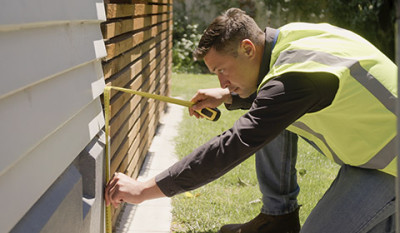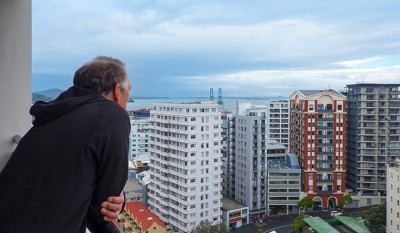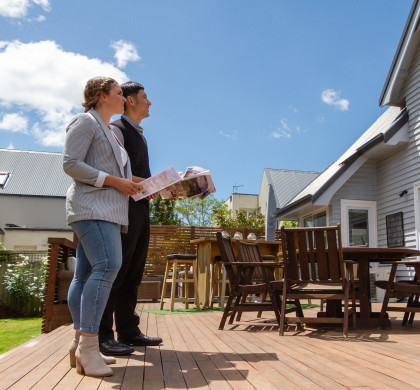Seek professional advice
Get a thorough pre-purchase inspection before purchasing a property. If you are looking at a property with a high level of natural hazard risk, we recommend asking a structural or geotechnical engineer(external link) to assess the level of risk
A lawyer or conveyancer will be able to help you understand any identified risks and make an informed decision. Consider the cost of any building work needed to make the house safer, and talk to your lawyer about how this might affect your offer.
You should also discuss your plans to purchase the property with your bank and your insurer.
Check the property documents
These documents are part of the official record of a property and are sometimes provided by the agent or seller. If they aren’t available, you can purchase them from the local council. You should ask your lawyer to review these.
Key property documents to seek out:
- record of title which can be purchased through Land Information New Zealand(external link)
- LIM reports (Land Information Memorandum), which can be purchased from the local council
- property file from the Council.
What to ask the real estate agent or seller
It’s important to ask the seller or the real estate agent if the property has had any previous damage from a natural hazard event. Some of the key questions you should ask about any property are.
- Is there an existing EQCover or NHCover claim on the property?
- Did the previous homeowner use their settlement funds to complete the agreed repairs?
- Are there any quality issues with repairs, or any missed damage still needing to be repaired?
- Is there any pre-existing damage to the property that is not related to a natural disaster?
You should ask for copies of any documents relating to assessed damage or the status of repairs. This could include information like:
- any reports they have obtained
- receipts and consenting documents for any repairs that have been done.
Give this information to the licenced building practitioner who is doing your pre-purchase inspection. They can check the property against those records.
If the seller is can’t provide the correct documents, you can make a request for claim information from us. Your lawyer or real estate agent can also make this request on your behalf.
We treat claim information requests as official information requests and aim to complete them within 20 working days.
Search the address on our natural hazards claim map
The Natural Hazard Portal claims map(external link) shows all settled EQCover and NHCover claims on properties in New Zealand from 1977 onwards. This information is freely available.
Search for the property’s address in the claims map and it will show you whether there are any previous natural hazard cover claims that have been settled, and what type of claim it was.
Get a pre-purchase inspection
Hire a licensed building practitioner to do a pre-purchase property inspection. We don’t recommend relying on any pre-purchase report provided by the seller.
A pre-purchase inspection is broad in scope and often begins with a builder's report. An inspection can help explain the general condition of the property and identify any potential issues or risks like:
- The existence of any alterations or additions to the property.
- A lack of building maintenance that may lead to future issues and costly repairs.
- Work that may be necessary to bring a home up to the standard required to obtain finance or insurance for the property, for example, re-wiring or re-plumbing.
- Any safety concerns, for example unsafe works or hazardous materials like asbestos.
- A history of issues such as settlement and subsidence, construction issues, and defects such as weathertightness.
An inspection might also include reports from specialists such as engineers, surveyors, electricians, plumbers and identify anything that warrants further investigation.
NHC assessments
A NHC assessment (formerly called an EQC assessment) is not a substitute for a pre-purchase inspection and shouldn’t be relied on when doing due diligence on a property.
The purpose of a NHC assessment is to record the damage to an insured residential building, following a natural hazard event. This is then used to create a scope of works, which sets out the strategy for repairing the damage, and the costs of those repairs. If a scope of works was used to settle a natural hazards cover claim it can be helpful to cross-check it with a building inspection check sheet.
Seek advice on section notices
If the record of title for a property has a section notice you should get legal advice. There are two types of section notices to be aware of, and both can have serious implications for your insurance. Read more on our Section notices page.
Section 72 notice
A section 72 notice is intended to make anyone with an interest in the property (such as potential buyers, banks, lenders and insurers) aware that the property is known to be affected by or at risk of a natural hazard. A section 72 notice may result in us fully or partly declining a claim.
They can also appear as section 36(2) if applied under the Building Act 1991, or section 641a if applied under the Local Government Act 1974. If the property you are considering buying has any one of these notices you should talk to a lawyer and your insurer.
Section 28 or 51 notice
A section 28 or 51 notice appears on property’s record of title in specific situations when NHC Toka Tū Ake has limited or cancelled natural hazards cover after cash settling a claim. This usually happens when there is significant damage to a property, and the homeowner has not taken steps towards making repairs, within a reasonable timeframe.
Check if shared buildings are up to standard
 If a unit, townhouse or apartment building is listed on a council register as ‘earthquake prone’ it could require strengthening soon to bring it up to standard, which might be costly.
If a unit, townhouse or apartment building is listed on a council register as ‘earthquake prone’ it could require strengthening soon to bring it up to standard, which might be costly.
Ask the real estate agent or vendor if they have any information about the strength or construction of the building, including what percentage of the New Building Standard it meets.
Councils are now required to assess the earthquake-prone level of all buildings that are two or more storeys high and include three or more residential units.
Take out insurance
If you are taking out a mortgage, your bank will require you to have insurance. To protect your new home you need to purchase private insurance that includes fire cover. This will give you automatic natural hazards cover from NHC Toka Tū Ake. It’s important to understand what is and isn’t covered by us, and also by your insurer.
The cost of rebuilding
For each natural hazard event that happens, there is a maximum that NHC Toka Tū Ake can pay towards rebuilding or repairing your home. This maximum amount is called the building cover cap and is generally $300,000 plus GST. Any cover over this amount is provided by your private insurance policy.
The maximum settlement amount that you can be paid is set out in the policy with your insurer and it’s important to regularly check that this is enough to rebuild. Online calculators such as the Cordell Calculator can help estimate your rebuild cost, but for a more accurate figure, ask a registered quantity surveyor, builder or architect to provide an estimate.
Limited cover for your land
NHC Toka Tū Ake provides limited cover for certain areas of land under and around your home, and limited cover for some bridges, culverts, and retaining walls. Land cover is not intended to be a comprehensive cover and it sometimes won’t be enough to fully repair all of the damage to your land after a natural hazard event. Learn more about the limits of land cover on our About natural hazards cover webpage.
Our natural hazards cover is the only land insurance that is available in New Zealand, and you can’t buy additional cover for land through your insurer. However, insurers may provide additional cover for some parts of your property such as retaining walls, and for parts of your property that we don’t cover such as your driveway surfaces and landscaping. Please talk to your insurer about what is included in your policy.
Neighbouring retaining walls
Retaining walls on the boundary or outside your property that protect or support your land may be your neighbour's responsibility to insure. They would also be responsible for making a claim for damage following a natural disaster. If your neighbours are uninsured, there won’t be any insurance cover to help repair the damage.
Insuring shared property
Navigating the claims process when you own shared property can be complex. If the owners of shared property each have different types of insurance, or no insurance at all, it may complicate any claims for the cost to repair that damage.
Some common challenges include:
- reaching an agreement around the level and type of insurance cover required
- understanding what is covered for each homeowner, and how cover is applied to each home and any shared areas
- deciding who will pay for any damage not covered by insurance
- reaching an agreement about how and when repairs will be carried out.
When natural disaster damage impacts shared land, such as a cross-lease or a shared driveway, insurers will work together to manage your land claim and your neighbours’ land claims.
Buying a home checklist
Download the checklist